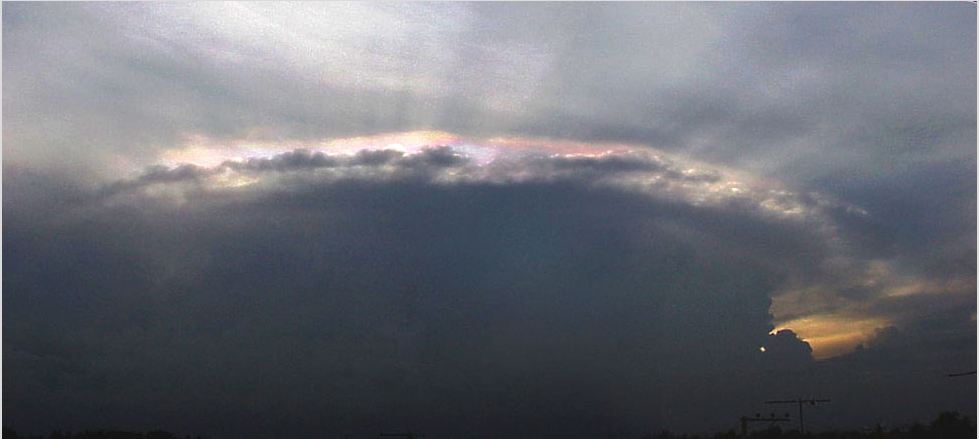Iridescence in pileus cloud III
Iridescence in Pileus Cloud III: A Spectacular Display of Nature's Colors
When it comes to atmospheric optics, one phenomenon that never fails to captivate our attention is iridescence. This stunning display of colors can be observed in various atmospheric conditions, including thin pileus clouds. In this article, we will delve deeper into the world of iridescence in pileus clouds and explore the mesmerizing interplay between light and water droplets that creates this ethereal spectacle.
What is a Pileus Cloud?
Before we dive into the details of iridescence, let's first understand what a pileus cloud is. Pileus clouds, also known as cap clouds, are a type of cloud formation that appears as a smooth, lenticular-shaped cloud layer above a rapidly growing cumulus or cumulonimbus cloud. These unique clouds form when moist air is forced upwards, causing condensation to occur rapidly at the top of the cloud. The result is a beautiful cap-like cloud formation that can sometimes exhibit iridescence.
The Science Behind Iridescence
Iridescence occurs when sunlight interacts with tiny water droplets or ice crystals suspended in the atmosphere. As light passes through these microscopic particles, it undergoes a process called diffraction, where the light waves are bent and scattered. This bending of light waves causes interference, leading to the separation of white light into its constituent colors. The result is a breathtaking display of shimmering hues that seem to dance across the sky.
Factors Influencing Iridescence in Pileus Clouds
Several factors come into play when it comes to the occurrence and intensity of iridescence in pileus clouds. These include:
-
Cloud Thickness: Thin pileus clouds tend to exhibit more pronounced iridescence due to the limited number of water droplets present.
-
Sun Angle: The angle at which sunlight interacts with the cloud plays a crucial role in the visibility of iridescence. When the sun is low on the horizon, its light passes through a greater thickness of the cloud, resulting in enhanced iridescence.
-
Droplet Size: The size of the water droplets within the cloud also affects the appearance of iridescence. Smaller droplets tend to produce more vivid colors, while larger droplets may lead to a softer, less vibrant display.
-
Cloud Composition: The composition of the cloud, including the presence of impurities or pollutants, can influence the colors observed in iridescence. These additional particles can scatter light differently, altering the overall appearance of the phenomenon.
Observing Iridescence in Pileus Clouds
To witness the mesmerizing beauty of iridescence in pileus clouds, it is important to be at the right place at the right time. Here are some tips for observing this natural spectacle:
-
Location: Seek out areas with frequent cloud formations, such as mountainous regions or coastal areas, where atmospheric conditions are conducive to the formation of pileus clouds.
-
Timing: Iridescence is most commonly observed when the sun is low on the horizon during sunrise or sunset. Be prepared to wake up early or stay out late to catch this fleeting phenomenon.
-
Equipment: While iridescence can sometimes be visible to the naked eye, having a pair of binoculars or a camera with a telephoto lens can enhance your viewing experience and allow you to capture its ephemeral beauty.
The Magic of Iridescence
The ethereal beauty of iridescence in pileus clouds serves as a reminder of the wonders of nature. This captivating display of colors brings a touch of magic to our skies, leaving us in awe of the intricate interplay between light and water droplets. Whether you are a seasoned sky-watcher or simply someone who appreciates the marvels of the natural world, taking the time to observe iridescence in pileus clouds is an experience that will leave an indelible mark on your memory.
In conclusion, iridescence in pileus clouds is a remarkable atmospheric phenomenon that showcases nature's ability to create breathtaking displays of color. By understanding the science behind iridescence and considering the various factors that influence its appearance, we can enhance our chances of witnessing this enchanting spectacle. So, the next time you find yourself gazing at the sky, keep an eye out for those wispy, lenticular clouds above thunderheads, for they may just gift you with a glimpse of nature's own kaleidoscope.

Iridescence in thin pileus cloud above a backlit thunder head. Crepuscular rays from the low sun add to the spectacle. Imaged in Bangkok,Thailand by Ian Jacobs. ©Ian Jacobs
Note: this article has been automatically converted from the old site and may not appear as intended. You can find the original article here.
Reference Atmospheric Optics
If you use any of the definitions, information, or data presented on Atmospheric Optics, please copy the link or reference below to properly credit us as the reference source. Thank you!
-
<a href="https://atoptics.co.uk/blog/iridescence-in-pileus-cloud-iii/">Iridescence in pileus cloud III</a>
-
"Iridescence in pileus cloud III". Atmospheric Optics. Accessed on April 20, 2024. https://atoptics.co.uk/blog/iridescence-in-pileus-cloud-iii/.
-
"Iridescence in pileus cloud III". Atmospheric Optics, https://atoptics.co.uk/blog/iridescence-in-pileus-cloud-iii/. Accessed 20 April, 2024
-
Iridescence in pileus cloud III. Atmospheric Optics. Retrieved from https://atoptics.co.uk/blog/iridescence-in-pileus-cloud-iii/.